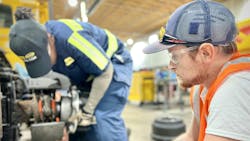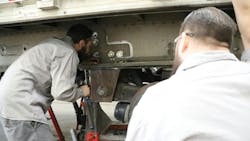Keys to tech mentoring: Lead by example then let 'em cook
This is Part Two of a two-part story. Click here to read Part One.
With disappointing technician shortage, retention, and satisfaction statistics seemingly unavoidable in the industry today, ensuring that new technicians feel challenged and motivated on a day-to-day basis is just as important as the tools and techniques used to train them.
Keeping techs engaged is essential for retention, especially as they’re just starting out, but there must be a balance. Entering the workforce in general can be daunting, especially in a hectic shop environment where time is money. It can be easy to get overwhelmed in regards to both the information intake during training and in the difficulty of the repair at hand.
“Back when I was a new tech, there would have been whole jobs where it’s like ‘I do not know where to start,’” reminisced Sean Wilkin, emergency field service technician for Cox Automotive Mobility Fleet Services. “Granted, looking back, some of these jobs were fairly simple. I just didn’t have the experience yet.
“I had some really good managers, supervisors, and other technicians that would let me struggle a little bit.” He explained that they wouldn’t show him exactly how to finish the job but would offer tips, such as the correct tool to use or method to approach the situation. “Essentially, [I was] still doing it on my own, just with a little bit of guidance, and for me that worked very well.”
According to Joe Whistler, a service advisor at Fyda Freightliner Youngstown, a safe bet is sometimes just a push in the right direction, while ultimately leaving the decision up to the technician.
“‘I think you can do this; do you think you can?’” he would ask a newer tech. “And if you can’t, let’s hit the ground running. Let’s try it out.”
Adequate compensation can also be a cause of stress when learning the basics, even more so from a flat-rate perspective.
In Fyda Freightliner Youngstown’s flat-rate environment, Whistler explained that they never put a new technician on 100% flat-rate pay until at least six months in. “Now, we will give them best of,” he noted. “If you’re a good performer, you will get your flat rate paid, but it’s not something to be concerned about if you’re not the fastest guy in the world. If you turn 44 hours, you’ll get paid 44 hours. But if you only turn 38 hours, and you’re on the clock for 40, you will get your 40.”
This hybrid structure provides newer technicians with a secure learning atmosphere where they’re encouraged to take the time required to do the job right. Without it, a new hire might rush through tasks they may not be as proficient at in order to make a living.
Leading by example
Videos and manuals can only take a newbie so far when compared to on-the-job training and shadowing from a mentor or more experienced technician.
“I’ve seen so many people come through here, I’ve been here over 20 years,” said Jim Petry, technician at Fyda Freightliner Youngstown. “The people that did make it and turned out to be good techs, it’s because they got to be decent friends with more experienced guys.”
Read more: Overachiever Awards: 'The Mentor' Dewey Bishop
Ray Erne, service operations manager at the Ohio-based Transport Services, acts on a similar premise. He noticed that only certain technicians were able to do certain jobs, and that not all of their technicians were well versed in a variety of repairs.
To fix this, “when we started hiring new technicians with minimal skills, we started cross training,” he said. “Every new technician worked a minimum of one to three weeks with every technician at the shop until he learned every skill out there. What that did is completely change our turnaround time for our customers.”
While this may not be an option for every shop out there, Erne explained that Transport Services’ 22 bays make cross training easier.
When it comes to more experienced technicians being reluctant to train or take new techs under their wing, this is a more complicated issue. This can be a result of time sensitivity, lack of fair compensation for training, or simply a bad attitude (from either tech).
Whistler said their new technicians get sent out with a more experienced tech to keep an eye on them.
He clarified that the more experienced tech won’t provide direct instruction, rather pointers and suggestions when the new tech might be struggling. “Like on a Detroit, ‘Hey, don’t have the oil and fuel filter out at the same time. Drop one, start it. Drop the other, start it.’”
Cox’s Wilkin agreed that this type of training is necessary but suggested that shops offer other options to keep pay fair and consistent. “If you have mentor techs or techs that want to take on that training responsibility, they need to be taken off of a flat rate or put on some kind of hybrid type of pay program,” he said.
Attitude and initiative
With payment taken care of and out of the way, attitude can be another roadblock to successful collaboration.
“Guys that walk in the door and are instantly cocky piss guys off that have years of experience,” Whistler pointed out. “When you’re new and you start out, you need to know that you’re new and you’re just starting out. Attitude goes 1,000 miles.”
“There’s a big difference between confidence and arrogance. You’re gonna need help,” said Petry. Care enough about doing things right that you can call on someone else as a resource, and that “will take you further than any software, any troubleshooting program, any set of standards we can come up with.”
On the training/management side, evolving is key. Every technician has different strengths, weaknesses, skill levels, and learning styles when they walk through the door for the first time. No blanket solution will work for everyone.
On the tech side, be flexible and receptive to help, but if you really want a leg up, absorb as much information as you can on your own. Even if your shop environment isn’t exactly conducive to extensive shadowing, the internet is full of experienced techs doing just that.
“There’s a huge community on Tik Tok of techs telling their daily stories, showing what they see, how they fix things,” Wilkin pointed out. “It’s not professional training by any means, but it gives real world viewpoints on what it’s like being a tech.”
“The best thing I tell newer guys is if you’re coming into a shop with little to no experience, be humble. Ask questions,” Wilkin concluded. “Don’t come in thinking that you have all the answers or that you can fix anything that comes through your bay door.”
About the Author

Lucas Roberto
Lucas Roberto is an Associate Editor for Fleet Maintenance magazine. He has written and produced multimedia content over the past few years and is a newcomer to the commercial vehicle industry. He holds a bachelor's in media production and a master's in communication from High Point University in North Carolina.

